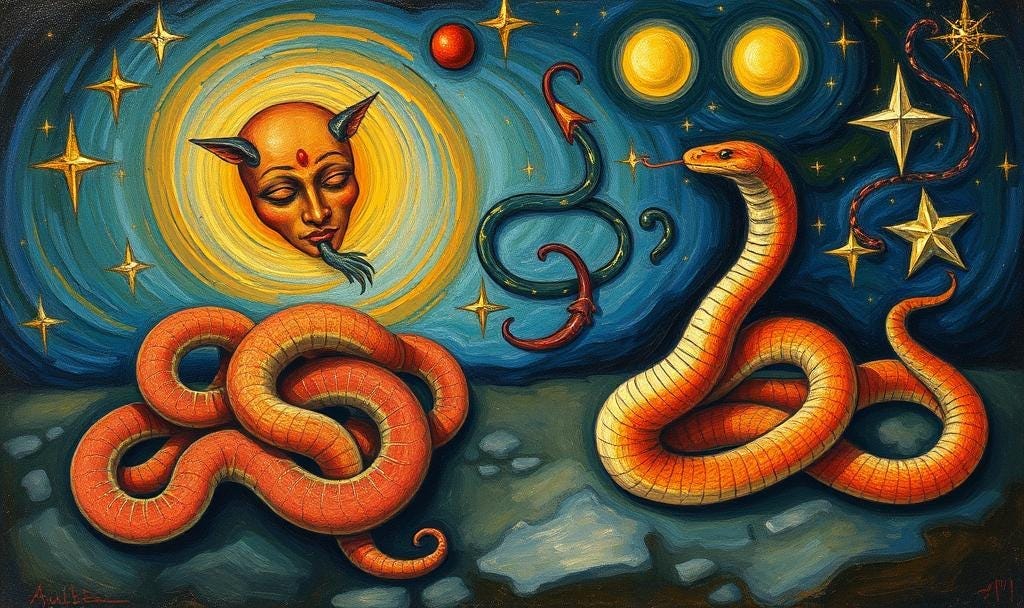Vedic astrology, also known as Jyotish Shastra, is a profound ancient system that delves deep into the cosmic influences shaping human lives. Among the many celestial entities analyzed in this system, Rahu and Ketu hold a uniquely mystical and powerful position. These two shadow planets, often termed the lunar nodes, play a critical role in shaping destiny, karmic lessons, and spiritual growth.

Who Are Rahu and Ketu?
Unlike the traditional planets visible in the sky, Rahu and Ketu are not physical celestial bodies but mathematical points where the Moon’s orbit intersects the Sun’s orbit (the ecliptic). These points are known as the North Lunar Node (Rahu) and the South Lunar Node (Ketu).
- Rahu is considered the ascending or north node.
- Ketu is the descending or south node.
In mythology and Vedic lore, Rahu and Ketu are linked to the story of the churning of the ocean (Samudra Manthan), where the demon Svarbhanu disguised himself to drink the nectar of immortality. The Sun and Moon exposed him, and Lord Vishnu severed his head. The head became Rahu, and the body became Ketu, eternally chasing each other across the skies, creating eclipses.
The Symbolism and Mysticism of Rahu and Ketu
Rahu and Ketu symbolize forces beyond the physical world—they represent karmic influences, spiritual shadows, illusions, and transformation. Where Rahu signifies worldly desires, obsession, and materialism, Ketu represents detachment, spirituality, and liberation.
Rahu: The Obsessive Seeker
Rahu is often seen as a planet of insatiable desire, ambition, and unconventional thinking. It governs foreign elements, technology, innovation, and sudden changes. People influenced strongly by Rahu tend to seek power, recognition, and worldly pleasures. However, Rahu can also bring confusion, deceit, and illusions if not balanced properly.
Ketu: The Detached Mystic
In contrast, Ketu symbolizes renunciation, enlightenment, and spiritual growth. It relates to past life karma, psychic abilities, and mystical experiences. Individuals with strong Ketu influences may have a deep sense of detachment from materialistic life and a natural inclination toward spirituality and self-realization.
Rahu and Ketu’s Role in the Birth Chart
In Vedic astrology, Rahu and Ketu are always exactly 180 degrees apart in a natal chart. They form an axis representing the karmic path of the individual.
- Rahu shows where the person’s desires and worldly attachments lie.
- Ketu indicates areas of life where the individual has past life experience and might feel naturally skilled but detached.
Their placement in the houses and signs of a horoscope profoundly influences one’s life direction, challenges, and spiritual lessons.
Impact on Life and Personality
Rahu’s Effects
- Drives ambition and worldly success.
- Can cause obsession, anxiety, and restlessness.
- Encourages innovation and breaking societal norms.
- May bring sudden ups and downs in life.
- Often linked to foreign connections or unusual experiences.
Ketu’s Effects
- Promotes spiritual insight and intuition.
- Encourages detachment and letting go.
- May cause confusion, isolation, or loss in material aspects.
- Can signify hidden talents or psychic abilities.
- Often related to past life karma and unresolved issues.
Rahu and Ketu in Transit: The Eclipse Connection
Rahu and Ketu’s transits are closely associated with solar and lunar eclipses, events considered highly significant in astrology. Eclipses bring sudden revelations, endings, or beginnings, urging transformation and karmic reckoning.
The 18-month cycle of Rahu and Ketu through different signs highlights periods of intense karmic activity where individuals may experience profound changes in life areas related to those signs and houses.
Remedies and Balancing the Shadow Planets
Because Rahu and Ketu can bring both challenges and growth opportunities, Vedic astrology offers various remedies to mitigate their adverse effects:
- Mantras: Chanting specific mantras like the Rahu Beej Mantra or Ketu Beej Mantra can pacify negative influences.
- Gemstones: Wearing stones like Hessonite (for Rahu) and Cat’s Eye (for Ketu) is believed to balance their energies.
- Pujas and Rituals: Performing rituals on specific days to appease these planets.
- Charity and Fasting: Acts of charity or fasting on certain days help reduce malefic effects.
- Spiritual Practices: Meditation and spiritual disciplines align with Ketu’s energy for growth and liberation.
Spiritual Lessons from Rahu and Ketu
Ultimately, Rahu and Ketu guide individuals on their karmic journey. Rahu challenges the soul to face desires and attachments in the material world, while Ketu encourages letting go and embracing spiritual truths. Together, they push for balance between the worldly and the divine.
Understanding their role in your horoscope helps navigate life’s complexities, avoid pitfalls, and harness their power for personal evolution.
Conclusion
Rahu and Ketu are more than just shadow planets; they are cosmic teachers of karma, transformation, and spirituality in Vedic astrology. Their mystical powers influence not only worldly experiences but also the soul’s journey toward enlightenment. Exploring the Mystical Power of Rahu and Ketu in Vedic Astrology reveals deep karmic influences shaping destiny. For expert guidance, consult a Famous Astrologer in Ahmedabad who offers personalized readings and powerful remedies to balance these shadow planets’ effects.
By respecting and working with their energies, one can turn potential obstacles into opportunities for profound growth and harmony.




